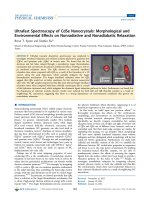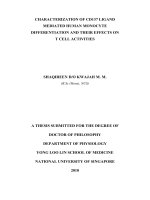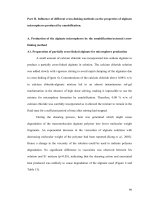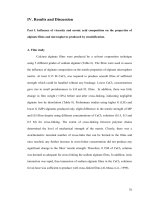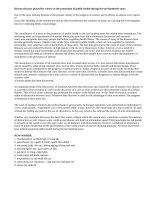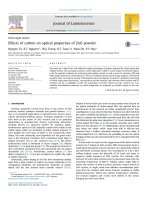evaluation of shape and size effects on optical properties of zno pigment
Bạn đang xem bản rút gọn của tài liệu. Xem và tải ngay bản đầy đủ của tài liệu tại đây (1.1 MB, 6 trang )
Applied
Surface
Science
270 (2013) 33–
38
Contents
lists
available
at
SciVerse
ScienceDirect
Applied
Surface
Science
j
our
nal
ho
me
p
age:
www.elsevier.com/loc
ate/apsusc
Evaluation
of
shape
and
size
effects
on
optical
properties
of
ZnO
pigment
Narges
Kiomarsipour
a,∗
, Reza
Shoja
Razavi
a
, Kamal
Ghani
b
,
Marjan
Kioumarsipour
c
a
Department
of
Materials
Engineering,
Malek
Ashtar
University
of
Technology,
Shahin
Shahr
P.O.
Box
83145/115,
Isfahan,
Iran
b
Department
of
Chemistry,
Malek
Ashtar
University
of
Technology,
Shahin
Shahr
P.O.
Box
83145/115,
Isfahan,
Iran
c
Department
of
Physics,
University
of
Kashan,
Kashan,
Iran
a
r
t
i
c
l
e
i
n
f
o
Article
history:
Received
16
July
2012
Received
in
revised
form
30
November
2012
Accepted
30
November
2012
Available online 10 December 2012
Keywords:
Zinc
oxide
pigment
Light
scattering
efficiency
Optical
property
Hydrothermal
method
a
b
s
t
r
a
c
t
The
pigment
with
optimized
morphology
would
attain
maximum
diffuse
solar
reflectance
at
a
lower
film
thickness
and
reduce
the
pigment
volume
concentration
required.
This
factor
would
contribute
to
a
reduction
in
overall
weight
and
possibly
extend
the
durability
of
the
system
to
longer
time
scales,
specially
in
space
assets.
In
the
present
work,
five
different
morphologies
of
ZnO
pigment
were
synthesized
by
hydrothermal
method.
The
ZnO
pigments
were
characterized
by
X-ray
diffraction
(XRD),
field-emission
scanning
electron
microscopy
(FE-SEM),
atomic
force
microscopy
(AFM)
and
N
2
adsorption
(BET).
The
optical
property
of
the
ZnO
pigments
was
investigated
by
UV/VIS/NIR
spectrophotometer.
The
results
indicated
that
the
optical
properties
of
ZnO
powders
were
strongly
affected
by
the
particle
size
and
morphology.
The
nanorods
and
microrods
ZnO
structures
showed
the
minimum
spectral
reflectance
in
visible
and
near
infrared
regions,
whereas
the
novel
nanoparticle-decorated
ZnO
pigment
revealed
the
maximum
spectral
reflectance
in
the
same
regions.
The
reflectance
spectra
of
scale-like
and
submicro-
rods
ZnO
were
in
the
middle
of
the
others.
The
higher
surface
roughness
led
to
higher
light
scattering
in
nanoparticle-decorated
ZnO
pigment
and
multiple-scattering
in
them.
These
results
proved
that
a
signif-
icant
improvement
in
the
scattering
efficiency
of
ZnO
pigment
can
be
realized
by
utilizing
an
optimized
nanoparticle-decorated
pigment.
© 2012 Elsevier B.V. All rights reserved.
1.
Introduction
Zinc
oxide
is
used
in
the
manufacture
of
paints,
rubber
prod-
ucts,
cosmetics,
pharmaceuticals,
floor
coverings,
plastics,
printing
inks,
soap,
storage
batteries,
textiles
and
electrical
equipment.
Addition
of
pigments
to
coatings
is
a
common
industrial
practice.
Pigments
not
only
provide
esthetics
to
the
coatings
but
also
help
in
improving
many
properties
of
the
coatings
such
as
UV
resistance,
corrosion
resistance
and
mechanical
properties
like
scratch
and
abrasion
[1].
Direct
fabrication
of
special
structures
with
controlled
crystalline
morphology
represents
significant
challenge
in
various
fields,
because
it
can
provide
a
better
model
for
investigating
the
dependence
of
electronic
and
optical
properties
on
the
size
confine-
ment
and
dimensionality
[2–5].
Various
ZnO
structures
including
nanobrushs
[6],
nanowires
[7],
nanobowls
[8]
and
nanopellets
[9]
have
been
produced.
They
are
widely
used
in
many
important
areas,
such
as
solar
cells
[10],
gas
sensors
[11],
electronics
[12]
and
photo-
catalysts
[13].
One
of
the
most
important
applications
of
ZnO
is
in
∗
Corresponding
author.
Tel.:
+98
312
5225041;
fax:
+98
312
5228530.
address:
(N.
Kiomarsipour).
the
paint
industry
as
pigment.
The
ZnO
is
a
white
powder
that
usu-
ally
used
as
pigment
and
by
volume
is
the
second
most
significant
white
pigment
[14].
There
are
several
potential
benefits
to
optimize
the
scatter-
ing
efficiency
of
the
ZnO
pigment
through
control
of
particle
size.
An
ideal
coating
design
would
obtain
the
theoretical
maximum
reflectance
(i.e.
opacity)
with
the
lowest
pigment
volume
concen-
tration
(PVC)
and
dry
film
thickness
(DFT).
Any
additional
pigment
does
not
contribute
to
scattering
and
is
detrimental
to
the
physi-
cal
properties
of
the
film
[15].
The
surface
texture
of
a
scattering
particle,
in
addition
to
the
overall
particle
geometric
shape,
is
also
an
important
morphological
factor
in
determining
the
opti-
cal
properties
of
the
scatter.
In
the
past
two
decades,
the
effect
of
asphericity
of
a
particle
on
its
single-scattering
parameters
(e.g.,
phase
function
and
cross
section)
has
been
extensively
investi-
gated.
However,
only
a
handful
of
studies
have
investigated
the
effect
of
surface
texture
or
roughness
on
particle
optical
properties
[16,17].
The
present
paper
is
focused
on
the
development
of
a
novel
morphology
of
ZnO
pigment
that
can
potentially
raise
the
scatter-
ing
efficiency
of
ZnO
pigment.
In
the
present
work,
five
different
morphologies
of
ZnO
were
synthesized
by
hydrothermal
method
and
then
the
morphology
effects
on
the
spectral
reflectance
were
studied.
0169-4332/$
–
see
front
matter ©
2012 Elsevier B.V. All rights reserved.
/>34 N.
Kiomarsipour
et
al.
/
Applied
Surface
Science
270 (2013) 33–
38
Table
1
Synthesis
conditions
of
hydrothermally
synthesized
ZnO
pigments.
Morphology
[Zinc
solution]
a
[Hydroxide
solution]
a
pH
of
final
solution
Temprature
(
◦
C)
Time
(h)
Scale-like
1.5
2.0
11
160
18
Submicrorods
0.5
1.5
12
150
20
Microrods 0.5
1.5
12
180
20
nanorods
0.5
1.5
12
120
20
Decorated-nanoparticles 1.0
4.0
12.5
170
14
a
The
concentration
of
zinc
nitrate
and
potassium
hydroxide
solutions
(Molar).
2.
Experimental
2.1.
Preparation
of
pigments
ZnO
samples
were
prepared
by
hydrothermal
method
and
used
for
the
evaluation
of
morphology
effects
of
ZnO
pigments
on
their
optical
properties.
The
synthesis
conditions
were
according
to
our
previous
works
[18,19].
Typical
synthesis
conditions
of
ZnO
pow-
ders
synthesized
in
this
work,
were
summarized
in
Table
1.
All
of
the
samples
were
prepared
as
follows:
The
zinc
nitrate
aqueous
solution
was
prepared
by
adding
appropriate
amount
of
Zn(NO
3
)
2
·6H
2
O
(Reagent
Grade,
98%
Sigma–Aldrich)
to
distilled
water.
The
pH
of
solution
increased
by
adding
dropwise
a
solution
of
KOH
(appropriate
amount
of
KOH
added
in
distilled
water)
and
stirring
vigorously
for
10
min
at
room
temperature.
Then
the
resulting
slurry
mixture
was
transferred
into
a
100
mL
Teflon-lined
stainless
steel
autoclave
up
to
80%
of
the
total
volume.
Hydrothermal
reaction
was
conducted
in
an
oven.
After
the
reaction
was
completed,
the
autoclave
was
cooled
very
slowly
to
room
temprature
and
the
final
product
was
collected
by
pressure
filtration.
Powdered
sample
was
thoroughly
washed
with
distilled
water
and
then
dried
in
air
at
120
◦
C
for
12
h.
2.2.
Characterization
of
pigments
Crystal
structure
of
as-prepared
products
was
characterized
by
powder
X-ray
diffraction
(XRD)
on
a
Bruker
D8
Advance
X-ray
diffractometer
using
Cu-K␣
radiation
(40
kV,
40
mA
and
=
0.1541
nm).
XRD
patterns
were
recorded
from
0
◦
to
90
◦
with
a
scanning
step
of
0.02
◦
/s.
Morphology
and
size
of
the
samples
were
analyzed
by
Hitachi
S-4160
Field
Emission
Scanning
Elec-
tron
Microscopy
(FE-SEM)
at
an
accelerating
voltage
of
15
kV.
The
diffuse
reflectance
spectra
of
prepared
powders
were
mea-
sured
by
JASCO
V-670
UV–vis
Spectrophotometer
(in
the
range
of
220–2200
nm).
The
specific
surface
areas
were
measured
by
Brunauer–Enmet–Teller
(BET)
method
employing
N
2
adsorption
at
77
K
after
treating
the
sample
at
170
◦
C
and
10
−4
Pa
for
2
h,
using
a
Tristar-3000
apparatus.
Atomic
force
microscopy
(AFM)
mea-
surements
for
ascertaining
the
surface
roughness
of
the
scale-like
and
nanoparticle-decorated
pigments
were
performed
by
atomic
force
spectroscope
(AFM;
DME
Dualscope
DS-95-200-E;
0.12
nN,
30
mm/s).
3.
Results
and
discussion
The
typical
XRD
patterns
of
the
products
are
shown
in
Fig.
1.
All
of
the
diffraction
peaks
can
be
indexed
as
hexagonal
wurtzite
ZnO
with
cell
constants
a
=
3.2490
˚
AÅ
and
c
=
5.2050
˚
AÅ
for
prod-
ucts,
in
good
agreement
with
the
reported
data
for
ZnO
(JCPDS
File,
00-005-0664).
The
very
sharp
diffraction
peaks
indicated
the
good
crystallinity
of
the
prepared
crystals
and
no
characteristic
peaks
were
detected
from
any
other
impurities
such
as
Zn(NO
3
)
2
·6H
2
O
and
Zn(OH)
2
.
Fig.
2(a–k)
shows
the
low-magnification
and
high-magnification
FE-SEM
images
of
the
five
corresponding
obtained
pigments:
scal-like,
submicrorods,
microrods,
nanorods
and
nanoparticle-
decorated
ZnO.
In
Fig.
2,
it
can
be
seen
that
the
morphology
of
ZnO
pigments
is
greatly
affected
by
the
hydrothermal
conditions.
Fig.
2(a)
and
(b),
shows
the
scale-like
ZnO,
which
all
of
the
scales
have
fairly
uniform
diameters
about
300
nm
and
thicknesses
of
50
nm.
In
Fig.
2(c)
and
(d),
FE-SEM
images
of
the
submicrorods
ZnO
is
shown.
The
diameters
of
ZnO
rods
are
about
100
nm
and
their
lenghts
are
up
to
2
m.
The
FE-SEM
images
of
the
microrods
ZnO
pigment
are
shown
in
Fig.
2(e)
and
(f).
The
lower
magnifica-
tion
Image
2(e)
indicates
that
the
highly
dispersed
microrod
ZnO
structures
have
diameters
of
about
200
nm
and
lengths
of
3
m.
The
FE-SEM
images
of
nanorod
ZnO
pigment
are
shown
in
Fig.
2(g)
and
(h).
It
is
found
that
the
product
is
composed
of
well-dispersed
Fig.
1.
XRD
patterns
of
the
as-synthesized
ZnO
pigments.
N.
Kiomarsipour
et
al.
/
Applied
Surface
Science
270 (2013) 33–
38 35
crystals
on
a
large
scale,
and
all
of
the
nanorods
have
diameters
of
about
50
nm
and
lengths
of
300
nm.
Fig.
2
(i–k)
exhibits
the
FE-
SEM
images
of
nanoparticle-decorated
ZnO
pigment.
The
surface
of
ZnO
pigment
was
decorated
by
nanoparticles
with
diameters
of
approximately
20–50
nm.
The
decorated
surface
of
pigment
was
led
to
increase
specific
surface
area
and
surface
roughness
of
particles
and
consequently,
increase
the
light
scattering
effi-
ciency
[16,20].
N
2
adsorption–desorption
results
further
confirmed
Fig.
2.
Low-
and
high-magnification
FE-SEM
images
of
ZnO
structures:
(a,
b)
Scale-like,
(c,
d)
submicrorods,
(e,
f)
microrods,
(g,
h)
nanorods
and
(i,
j,
k)
nanoparticle-decorated
ZnO.
36 N.
Kiomarsipour
et
al.
/
Applied
Surface
Science
270 (2013) 33–
38
Fig.
2.
(Continued).
the
porous
surface
feature
of
the
nanoparticle-decorated
ZnO
pig-
ment.
The
representative
isotherm
of
the
ZnO
pigment
is
shown
in
Fig.
3.
The
N
2
isotherm
plot
belongs
to
the
type
IV
isotherm
in
the
Brunauer
classification
[21].
A
hysteresis
loop
observed
at
higher
relative
pressures
(P/P
0
=
0.5–0.9)
is
associated
with
the
filling
and
emptying
of
mesoporous
(10–30
nm
in
diameter)
by
capillary
con-
densation.
According
to
the
IUPAC
classifications,
the
observed
loop
0
20
40
60
0
0.5
1
Va/cm3(STP) g-1
p/p
0
ADS
DES
Fig.
3.
Typical
N
2
adsorption–desorption
isothermal
of
the
nanoparticle-decorated
ZnO
pigment.
indicates
the
H
3
type,
implying
the
presence
of
mesoporous
[21].
The
BET
surface
area
of
the
nanoparticle-decorated
ZnO
pigment
was
calculated
to
be
only
6.3712
m
2
/g.
The
surface
of
the
particles
was
decorated
by
nanoparticles
with
diameters
of
approximately
20–50
nm,
on
which
mesoporous
with
diameter
ranging
from
10
to
30
nm
were
formed
among
nanoparticles
simultaneously.
The
experimentally
measured
specular-included
UV/VIS/NIR
reflectance
spectra
of
ZnO
pigments
are
shown
in
Fig.
4.
It
can
be
seen
that
the
optical
property
was
greatly
affected
by
morphology
and
particle
size
of
pigments.
The
particle
size
of
the
pigment
plays
an
important
role
in
light
scattering
efficiency
[15,22,23].
Wave
theories
of
light
account
for
bending
phenomena
which
give
rise
to
scattering.
Light
scattering
by
this
mechanism
increases
with
decreasing
particle
size
until
an
optimum
is
reached
at
approximately
half
the
wavelenght
of
light.
Optimal
particle
size
for
scattering
can
be
calculated,
and
also
depends
on
wavelength
[24].
The
scattering
efficiency
is
extremely
dependent
upon
the
par-
ticle
size
distribution
of
the
pigment.
It
is
well
known
from
Mie
scattering
theory
that
as
the
pigment
particle
diameter
approaches
approximately
one-half
that
of
the
incident
radiation
wavelength,
scattering
is
increased
dramatically.
The
results
of
the
modeling
indicated
that
an
optimum
particle
size
of
distribution
would
be
between
between
0.25
and
0.45
m,
and
particles
greater
than
1.5
m
provide
very
little
Mie
scattering
contributions
[22,23].
It
is
quite
evident
from
the
contour
plot
that
ZnO
particle
diameter
greater
than
approximately
1.5
m
do
not
scatter
light
efficiency
at
any
wavelength
[15].
When
particle
sizes
are
large
(greater
than
1.5
m),
reflectance
is
relatively
low.
As
particle
size
decreases,
reflectance
increases
as
the
number
of
first-surface
reflections
and
the
amount
of
multiple
scattering
increases.
Further
decreases
in
particle
size
result
in
an
improvement
of
the
reflectance.
As
parti-
cle
size
decreases
such
that
the
size
is
less
than
the
wavelength,
the
particle
as
a
whole
interacts
with
a
wavelength
of
light
[25].
N.
Kiomarsipour
et
al.
/
Applied
Surface
Science
270 (2013) 33–
38 37
0
20
40
60
80
100
0 50
0 100
0 150
0 200
0 250
0
Reflectance (%)
Wavelenght
(nm)
Nanop
article-decorated Z
nO
Scale-li
ke ZnO
Submic
rorod
s ZnO
Microrods ZnO
Nanorods Z
nO
Fig.
4.
Experimental
specular-included
UV/VIS/NIR
reflectance
spectra
of
as-synthesized
ZnO
pigments.
From
Fig.
4,
it
can
be
observed
that
the
spectral
reflectances
of
nanorod
and
microrod
ZnO
pigments
are
lower
than
the
others.
Because
of
the
particle
sizes
of
nanorod
and
microrod
ZnO
pig-
ments
are
smaller
and
greater
than
the
optimal
particle
size
range
of
0.25–1.5
m,
respectively,
hence
do
not
scatter
light
efficienty
at
any
wavelength
[15].
The
observed
high
light
absorption
in
UV
region
(at
wavelengths
below
366
nm)
indicated
in
Fig.
4
is
due
to
ZnO
band
gap
and
this
phenomenon
is
one
of
the
most
important
ZnO
characteristics
[14].
The
particle
sizes
of
scale-like
and
submi-
crorod
ZnO
pigments
are
in
the
optimum
range
of
0.25–0.45
m,
and
their
UV/VIS/NIR
reflectance
spectra
have
the
suitable
amount
for
pigmentation
applications.
Consequently,
the
decorated
surface
of
new
ZnO
pigment
led
to
higher
light
reflectance.
The
decorated
surface
with
nanoparticles
led
to
increasing
of
special
surface
area
and
consequently
increasing
the
light
scattering.
The
presence
of
nanoparticles
on
the
surface
of
pigment
caused
increase
surface
roughness
and
more
chance
for
light
to
be
refracted.
The
higher
reflectance
of
new
morphology
also
can
be
attributed
to
more
dif-
ference
between
the
refractive
indices
ZnO
and
air-voids
in
pigment
mesoporous
structure
(between
in
particles).
The
nanoparticle-
decorated
ZnO
pigments
similar
to
particles
containing
air
voids
led
to
higher
reflectance
index
due
to
much
difference
between
the
refractive
indices
of
ZnO
and
air
voids
and
hence
increased
the
light
scattering
[26].
The
AFM
images
of
scale-like
and
nanoparticle-decorated
ZnO
pigments
are
presented
in
Fig.
5.
As
can
be
seen
in
this
figure
(Fig.
5),
the
surface
roughness
of
nanoparticle-decorated
ZnO
is
higher
and
more
uniform
than
scale-like
ZnO.
The
scattering
of
light
by
small
particles
is
determined
not
only
by
the
composition
of
the
incident
light
and
the
optical
properties
of
the
particles
and
the
medium
but
also
by
the
size,
shape,
con-
centration,
surface
roughness,
spatial
arrangement
of
the
particles,
etc.
Many
studies
had
shown
that
surface
roughness
can
indeed
play
an
important
role
on
the
light
scattering
pattern
under
certain
conditions
[27–30].
The
initial
theoretical
studies
and
subsequent
experimental
studies
of
multiple-scattering
effects
were
carried
out
for
randomly
rough
surfaces
characterized
by
rms
heights
of
the
order
of
5–10
nm,
and
transverse
correlation
lengths
of
the
order
of
100
nm,
i.e.
surfaces
with
nanoscale
roughness.
Subse-
quent
experimental
and
theoretical
work
was
devoted
to
the
study
of
surfaces
that
were
significantly
rougher
than
these,
e.g.
surfaces
with
microscale
roughness.
This
is
because
some
of
the
methods
Fig.
5.
AFM
images
of:
(a)
nanoparticle-decorated
and
(b)
scale-like
ZnO
pigments.
38 N.
Kiomarsipour
et
al.
/
Applied
Surface
Science
270 (2013) 33–
38
developed
for
treating
scattering
from
surfaces
with
this
larger
scale
of
roughness,
especially
computational
methods,
can
also
be
used
in
the
study
of
scattering
from
surfaces
with
nanoscale
roughness,
and
some
of
the
results
obtained
in
studies
of
sur-
faces
with
the
larger
scale
roughness
also
apply
to
surfaces
with
nanoscale
roughness
[31].
Another
study
indicated
that
a
good
correlation
was
between
the
surface
roughness
from
AFM
and
opti-
cal
reflection
measurements.
In
addition,
angle-resolved
reflection
measurements
gave
an
account
on
the
decrease
in
optical
scat-
tering
after
polishing
the
sample
surface.
In
this
case,
the
angular
reflection
distribution
is
similar
to
that
of
a
thin
sample
with
low
surface
roughness
and
shows
that
the
measured
optical
scattering
is
mainly
determined
by
the
surface
roughness
[32].
On
the
other
hand,
it
is
evident
that
increasing
surface
roughness
strongly
affects
the
scattering
properties
of
ice
particles
[33].
The
higher
surface
roughness
of
nanoparticle-decorated
ZnO
led
to
multiple
scatter-
ing
and
increasing
of
the
reflectance.
Presence
of
nanoparticles
on
the
pigment
surface
enhanced
the
multiple
scattering
for
whole
of
wavelength
range
[34,35].
4.
Conclusions
Well-dispersed
five
different
morphologies
of
ZnO
pigment
was
synthesized
by
a
simple
hydrothermal
method.
Evaluation
of
their
optical
properties
indicated
that
the
spectral
reflectance
was
strongly
affected
by
particle
shape
and
size.
Nanorod
and
microrod
ZnO
pigments
had
shown
the
lower
reflectance
spectra,
because
their
particle
size
were
not
in
the
optimum
range
and
they
do
not
scatter
light
efficiently
at
any
wavelength.
Scale-like
and
sub-
microrod
ZnO
pigments
had
shown
mean
reflectance.
The
novel
nanoparticle-decorated
ZnO
pigment
showed
the
highest
spectral
reflectance
and
it
is
promising
to
be
applied
in
paint
coatings
due
to
its
excellent
VIS/NIR
reflectance
property.
The
higher
surface
roughness
of
nanoparticle-decorated
ZnO
pigment
led
to
higher
multiple
scattering
and
higher
reflectance.
References
[1]
S.K.
Dhoke,
A.S.
Khanna,
T.J.
Mangal
Sinha,
Effect
of
nano-ZnO
particles
on
the
corrosion
behavior
of
alkyd-based
waterborne
coatings,
Progress
in
Organic
Coatings
64
(2009)
371–382.
[2]
S.H.
Ko,
I.
Park,
H.
Pan,
N.
Misra,
M.S.
Rogers,
ZnO
nanowire
network
transistor
fabrication
on
a
polymer
substrate
by
low-temperature,
all-inorganic
nanopar-
ticle
solution
process,
Applied
Physics
Letters
92
(2008)
154102–154103.
[3]
Y.
Khan,
S.K.
Durrani,
M.
Mehmood,
J.
Ahmad,
M.R.
Khan,
S.
Firdous,
Low
tem-
perature
synthesis
of
fluorescent
ZnO
nanoparticles,
Applied
Surface
Science
257
(2010)
1756–1761.
[4]
Y.F.
Zhu,
W.Z.
Shen,
Synthesis
of
ZnO
compound
nanostructures
via
a
chem-
ical
route
for
photovoltaic
applications,
Applied
Surface
Science
256
(2010)
7472–7477.
[5]
L.
Feng,
A.
Liu,
J.
Wei,
M.
Liu,
Y.
Ma,
B.
Man,
Synthesis,
characterization
and
opti-
cal
properties
of
multipod
ZnO
whiskers,
Applied
Surface
Science
255
(2009)
8667–8671.
[6] J.
Wang,
H.
Zhuang,
J.
Li,
P.
Xu,
Synthesis,
morphology
and
growth
mechanism
of
brush-like
ZnO
nanostructures,
Applied
Surface
Science
257
(2011)
2097–2101.
[7]
C.C.
Lin,
Y.Y.
Li,
Synthesis
of
ZnO
nanowires
by
thermal
decomposition
of
zinc
acetate
dihydrate,
Materials
Chemistry
and
Physics
113
(2009)
334–337.
[8]
Y.
Wang,
X.
Chen,
J.
Zhang,
Z.
Sun,
Y.
Li,
K.
Zhang,
B.
Yang,
Fabrication
of
surface-patterned
and
free-standing
ZnO
nanobowls,
Colloids
and
Surfaces
A
329
(2008)
184–189.
[9]
W.S.
Chiu,
P.S.
Khiew,
D.
Isa,
M.
Cloke,
S.
Radiman,
R.A.
Shukor,
M.H.
Abdullah,
N.M.
Huang,
Synthesis
of
two-dimensional
ZnO
nanopellets
by
pyrolysis
of
zinc
oleate,
Chemical
Engineering
Journal
142
(2008)
337–343.
[10]
H.
Zhao,
X.
Su,
F.
Xiao,
J.
Wang,
J.
Jian,
Synthesis
and
gas
sensor
properties
of
flower-like
3D
ZnO
microstructures,
Materials
Science
and
Engineering
B
176
(2011)
611–615.
[11]
J.
Huang,
Y.
Wu,
C.
Gu,
M.
Zhai,
Y.
Sun,
J.
Liu,
Fabrication
and
gas-sensing
prop-
erties
of
hierarchically
porous
ZnO
architectures,
Sensors
an
Actuators
B
155
(2011)
126–133.
[12]
S.M.
Peng,
Y.K.
Su,
L.W.
Ji,
S.J.
Young,
C.N.
Tsai,
W.C.
Chao,
Z.S.
Chen,
C.Z.
Wu,
Semitransparent
field-effect
transistors
based
on
ZnO
nanowire
networks,
IEEE
Electron
Device
Letters
32
(2011)
533–535.
[13] O.
Akhavan,
M.
Mehrabian,
K.
Mirabbaszadeh,
R.
Azimirad,
Hydrothermal
syn-
thesis
of
ZnO
nanorod
arrays
for
photocatalytic
inactivation
of
bacteria,
Journal
of
Physics
D:
Applied
Physics
42
(2009)
225305.
[14]
G.
Buxbaum,
Industrial
Inorganic
Pigments,
Second
ed.,
Wiley-VCH
Verlag
GmbH,
D-69469,
Weinheim,
1998.
[15]
J.A.
Johnson,
J.J.
Heidenreich,
R.A.
Mantz,
P.M.
Baker,
M.S.
Donley,
A
multiple-
scattering
model
analysis
of
zinc
oxide
pigment
for
spacecraft
thermal
control
coatings,
Progress
in
Organic
Coatings
47
(2003)
432–442.
[16] C.
Li,
G.W.
Kattawar,
P.
Yang,
Effects
of
surface
roughness
on
light
scattering
by
small
particles,
Journal
of
Quantitative
Spectroscopy
and
Radiative
Transfer
89
(2004)
123–131.
[17] J.
Krc,
M.
Zeman,
O.
Kluth,
F.
Smole,
M.
Topic,
Effect
of
surface
roughness
of
ZnO:Al
films
on
light
scattering
in
hydrogenated
amorphous
silicon
solar
cells,
Thin
Solid
Films
426
(2003)
296–304.
[18]
N.
Kiomarsipour,
R.
Shoja
Razavi,
Characterization
and
optical
property
of
ZnO
nano-,
submicro-
and
microrods
synthesized
by
hydrothermal
method
on
a
large-scale,
Superlattices
and
Microstructures
52
(2012)
704–710.
[19]
N.
Kiomarsipour,
R.
Shoja
Razavi,
Hydrothermal
synthesis
and
optical
prop-
erty
of
scale-like
and
spindle-like
ZnO,
Ceramics
International
39
(2013)
813–818.
[20]
J.E.
Van
Nostrand,
R.
Cortez,
Z.P.
Rice,
N.C.
Cady,
M.
Bergkvist,
Local
transport
properties,
morphology,
microstructure
and
transport
properties
of
ZnO
deco-
rated
SiO
2
nanoparticles,
Nanotechnology
21
(2010)
415602,
IOP
Publishing.
[21]
L.
Zhang,
J.
Zhao,
J.
Zheng,
L.
Li,
Z.
Zhu,
Hydrothermal
synthesis
of
hierarchical
nanoparticle-decorated
ZnO
microdisks
and
the
structure-enhanced
acetylene
sensing
properties
at
high
temperatures,
Sensors
and
Actuators
B
158
(2011)
144–150.
[22]
J.A.
Johnson,
A.I.
Haines,
L.A.
Bedrossian,
M.T.
Kenny,
Development
of
improved
thermal
control
coatings
for
space
assets,
AFRL-ML-WP-TP-2004-411,
2004.
[23]
E.S.
Berman,
J.A.
Johnson,
R.A.
Mantz,
P.S.
Meltzer,
Spacecraft
materials
develop-
ment
programs
for
thermal
control
coatings
and
space
environmental
testing,
The
AMPTIAC
Quarterly
8
(2004)
58–66.
[24]
R.
Lambourne,
T.A.
Strivens,
Paint
and
Surface
Coatings:
Theory
and
Practice,
Second
ed.,
William
Andrew
Publishing,
Cambridge,
1999.
[25] J.F.
Mustard,
J.E.
Hays,
Effects
of
hyperfine
particles
on
reflectance
spectra
from
0.3
to
25
m,
Icarus
125
(1997)
145–163.
[26]
N.
Kiomarsipour,
R.
Shoja
Razavi,
K.
Ghani,
Improvement
of
spacecraft
white
thermal
control
coatings
using
the
new
synthesized
Zn-MCM-41
pigment,
Dyes
and
Pigments
96
(2013)
403–406.
[27] K.
Nelson,
Y.
Deng,
Effect
of
polycrystalline
structure
of
TiO2
particles
on
the
light
scattering
efficiency,
Journal
of
Colloid
and
Interface
Science
319
(2008)
130–139.
[28] R.D.
Geil,
M.
Mendenhall,
R.A.
Weller,
B.R.
Rogers,
Effects
of
multiple
scatter-
ing
and
surface
roughness
on
medium
energy
backscattering
spectra,
Nuclear
Instruments
and
Methods
in
Physics
Research
Section
B
256
(2007)
631–637.
[29]
B.R.
Nag,
M.
Das,
Scattering
potential
for
interface
roughness
scattering,
Applied
Surface
Science
182
(2001)
357–360.
[30]
M.
Kahnert,
T.
Nousiainen,
M.A.
Thomas,
J.
Tyynelä,
Light
scattering
by
parti-
cles
with
small-scale
surface
roughness:
comparison
of
four
classes
of
model
geometries,
Journal
of
Quantitative
Spectroscopy
and
Radiative
Transfer
113
(2012)
2356–2367.
[31]
A.A.
Maradudin,
Light
scattering
and
nanoscale
surface
roughness,
in:
Nano-
structure
Science
and
Technology,
National
Research
Council
of
Canada,
Ottawa,
2007.
[32] R.
Bruggemann,
P.
Reinig,
M.
Hölling,
Thickness
dependence
of
optical
scat-
tering
and
surface
roughness
in
microcrystalline
silicon,
Thin
Solid
Films
427
(2003)
358–361.
[33]
M.I.
Mishchenko,
L.D.
Travis,
Scattering,
Absorption
and
Emission
of
Light
by
Small
Particles,
Revised
electronic
edition,
Goddard
Institute
for
Space
Studies,
New
York,
2004.
[34]
R.T.
Zaera,
J.
Elias,
C.L.
Clément,
ZnO
nanowire
arrays:
optical
scattering
and
sensitization
to
solar
light,
Applied
Physics
Letters
93
(2008)
233119.
[35]
E.
Pál,
V.
Hornok,
A.
Oszkó,
I.
Dékány,
Hydrothermal
synthesis
of
prism-like
and
flower-like
ZnO
and
indium-doped
ZnO
structures,
Colloids
and
Surfaces
A:
Physicochemical
and
Engineering
Aspects
340
(2009)
1–9.

